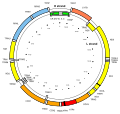Cytochrome c oxidase
Cytochrome c oxidase (complex IV, CcO), is the last enzyme in the respiratory electron transport chain of mitochondria. It is located in the mitochondrial membrane and plays a critical role in the bioenergetics of the cell, being responsible for the final step in the oxidative phosphorylation pathway, where electrons from cytochrome c are transferred to oxygen, the final electron acceptor, reducing it to water. This process is fundamental for the production of adenosine triphosphate (ATP), the cell's main energy-carrying molecule.
Structure[edit]
Cytochrome c oxidase is a complex enzyme consisting of multiple subunits. In mammals, it is composed of 14 subunits, with three core subunits (I, II, and III) encoded by mitochondrial DNA, and the remaining ones by nuclear DNA. The enzyme also contains several metal centers, including two heme groups (a and a3) and two copper centers (CuA and CuB), which play crucial roles in the electron transfer process.
Function[edit]
The primary function of cytochrome c oxidase is to catalyze the reduction of oxygen to water, a process that is coupled with the pumping of protons across the mitochondrial membrane. This proton gradient is then used by ATP synthase to generate ATP from ADP and inorganic phosphate. The activity of cytochrome c oxidase is tightly regulated, as the uncontrolled reduction of oxygen can lead to the production of harmful reactive oxygen species (ROS).
Regulation[edit]
The activity of cytochrome c oxidase is regulated by the availability of its substrates (cytochrome c and oxygen) and by the concentration of ATP and ADP in the mitochondria. High levels of ATP inhibit the enzyme, while high levels of ADP activate it, thus linking the enzyme's activity to the energy needs of the cell.
Clinical Significance[edit]
Mutations in the genes encoding cytochrome c oxidase subunits or assembly factors can lead to a group of mitochondrial diseases known as cytochrome c oxidase deficiency syndromes. These conditions are characterized by a wide range of symptoms, including muscle weakness, neurological disorders, and lactic acidosis, reflecting the enzyme's key role in cellular energy production.
Research[edit]
Research on cytochrome c oxidase continues to be a vibrant field, with studies focusing on understanding its detailed mechanism of action, its regulation, and its role in disease. Insights into the enzyme's function and regulation have potential implications for the development of therapies for mitochondrial diseases and conditions associated with mitochondrial dysfunction.
Cytochrome_c_oxidase[edit]
-
Cytochrome C Oxidase 1OCC in Membrane
-
Cmplx4
-
Map of the human mitochondrial genome
-
Mitochondrial electron transport chain (annotated diagram)
-
Komplex IV
Ad. Transform your life with W8MD's Budget GLP-1 injections from $75


W8MD offers a medical weight loss program to lose weight in Philadelphia. Our physician-supervised medical weight loss provides:
- Weight loss injections in NYC (generic and brand names):
- Zepbound / Mounjaro, Wegovy / Ozempic, Saxenda
- Most insurances accepted or discounted self-pay rates. We will obtain insurance prior authorizations if needed.
- Generic GLP1 weight loss injections from $75 for the starting dose.
- Also offer prescription weight loss medications including Phentermine, Qsymia, Diethylpropion, Contrave etc.
NYC weight loss doctor appointmentsNYC weight loss doctor appointments
Start your NYC weight loss journey today at our NYC medical weight loss and Philadelphia medical weight loss clinics.
- Call 718-946-5500 to lose weight in NYC or for medical weight loss in Philadelphia 215-676-2334.
- Tags:NYC medical weight loss, Philadelphia lose weight Zepbound NYC, Budget GLP1 weight loss injections, Wegovy Philadelphia, Wegovy NYC, Philadelphia medical weight loss, Brookly weight loss and Wegovy NYC
|
WikiMD's Wellness Encyclopedia |
| Let Food Be Thy Medicine Medicine Thy Food - Hippocrates |
Medical Disclaimer: WikiMD is not a substitute for professional medical advice. The information on WikiMD is provided as an information resource only, may be incorrect, outdated or misleading, and is not to be used or relied on for any diagnostic or treatment purposes. Please consult your health care provider before making any healthcare decisions or for guidance about a specific medical condition. WikiMD expressly disclaims responsibility, and shall have no liability, for any damages, loss, injury, or liability whatsoever suffered as a result of your reliance on the information contained in this site. By visiting this site you agree to the foregoing terms and conditions, which may from time to time be changed or supplemented by WikiMD. If you do not agree to the foregoing terms and conditions, you should not enter or use this site. See full disclaimer.
Credits:Most images are courtesy of Wikimedia commons, and templates, categories Wikipedia, licensed under CC BY SA or similar.
Translate this page: - East Asian
中文,
日本,
한국어,
South Asian
हिन्दी,
தமிழ்,
తెలుగు,
Urdu,
ಕನ್ನಡ,
Southeast Asian
Indonesian,
Vietnamese,
Thai,
မြန်မာဘာသာ,
বাংলা
European
español,
Deutsch,
français,
Greek,
português do Brasil,
polski,
română,
русский,
Nederlands,
norsk,
svenska,
suomi,
Italian
Middle Eastern & African
عربى,
Turkish,
Persian,
Hebrew,
Afrikaans,
isiZulu,
Kiswahili,
Other
Bulgarian,
Hungarian,
Czech,
Swedish,
മലയാളം,
मराठी,
ਪੰਜਾਬੀ,
ગુજરાતી,
Portuguese,
Ukrainian






